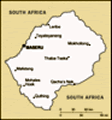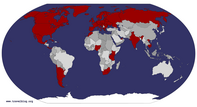Advertisement
6:00 a.m. Dawn is slowly breaking over the mountains outside my window. The air is so clear that I see the light as pale gold.
The generator is turned on only from five to ten in the evening, so ay 10:05 last night it was pitch black in the room. The stars and moon shone brightly, casting just enough light to grant contours to the trees.
A tiny puffy apricot cloud has just appeared above the mountain ridge horizon.
With the growing light, I realized I was watching a sideshow. Due east was located in the sitting room. I quietly opened the glass doors and in the cool pleasant fresh air watched as a streak of bright gold slowly blazed into bright sun. The surrounding peaks had little cloudy gold crowns.
1:45 p.m. In the silence of a hot afternoon, punctuated by occasional bird calls and the munching of a horse tethered nearby, I am almost overwhelmed by our morning village visit. Each visit in this tour is more extraordinary than the last one.
We walked slowly uphill with Moeti Maile, our young guide, or perhaps more an escort since he explained very little. (This is

 Generous farmer
Generous farmer
Delicious, firm little dried peacheshis first job after graduating from high school.) Our group was thrilled with everything, from the subsistence farms with neat, flourishing gardens, to the passers-by in bright clothes. Lots of people favour bright pink, in particular. At one home, a woman was in her yard tending her drying peaches. The colours were made for photography, so we snapped our cameras. She was so happy to show off her produce that she fetched a bowl of fully dried peaches from her house and offered a taste to each of us. Throughout the village peach trees were laden with small fruit.
We made our way to a wool project building. Inside the large, relatively modern, stone building, Mathuso Nkesi was waiting for us, occupying her time pulling sheep’s wool apart, cleaning it from seeds and burrs. She then carded this white portion and started over on a dark brown portion. When both were about the same, she carded them together, making a flecked medium brown. She moved over to a treadle spinning wheel, showed how she threaded it with a string, tied the string to the wool, and spun the wool onto a spool. She had some darker wool and spun

 Kindergarten class
Kindergarten class
Excited welcome to Ramabanta Primary that also. Then she wound the light brown yard onto a wooden form to make a skein. Then she twisted the lighter and darker yarns together to make a tweed yarn, and she showed us her knitted sweater from similar yarn. With the natural lanolin in the yarn, the product will be warm and rain/snow resistant, if not waterproof. We gave her tips, and she smiled widely saying she would buy more wool.
We wandered along some more, snapping photos like mad. I later asked Moeti if the village would be talking about us this evening, astonished of what we photographed. He gave that sheepish mumbling grin that means the world over – yes!
Our destination was the school. At first we interacted with kids who happened to be outside: “Hi!”, waving and thumbs up, which seems to be a universal symbol of “good” or “thanks” or “hello” in Southern Africa.
Fetched by Moeti, the school principal (Matumelo Ramanamane) came to greet us. She was a big woman full of confidence and enthusiasm, very directive in her speech. Over the next half hour or so, she took us into each classroom. We caused riot after riot! She

 Form 6 and 7
Form 6 and 7
We didn't want to interrupt - no chance!introduced us and talked about the lessons, but as soon as we started taking photos, the kids got excited, and when we turned the screens to let them see themselves, excitement overflowed! They couldn’t get enough of recognizing themselves and their friends. The principal dragged us away to the next classroom only for us to upset discipline again.
Some lessons stand out. The form six and seven students were learning about food preservation, such as bottling (canning) for food stuffs local to the region. In form two the principal showed us how she had taught the students the regions of Lesotho with a physical exercise: they stretched arms up and then out; they used their arms to point to each of the regions, like on a clock. Form three were learning fractions on the blackboard and with craft paper showing various examples. As we finished the touring, it was lunchtime. Each student put their “lunch box” (a bowl) on the floor at the front of the classroom, and it was filled with “papa” (stiff corn porridge) and some stew on top. If this was ever hot, it certainly wasn’t by the time we left the classroom.
The principal
brought us to her office, a single room that also served as the teachers’ room and the library. She herself was a student at this school and returned in 1983 to teach. She married in 1984 and continued her studies for three teaching certificates and finally a university degree. Twenty years ago she was promoted to principal and is now the regional coordinator for eight schools.
Many of the bright energetic students here are AIDS orphans. If they want to go to high school, she helps them get bursaries to pay for non-tuition costs. Although the government funds tuition, there have no money provided for maintenance, and the once-sponsoring Catholic church no longer gives them money, although the school is still denominated Catholic. However, parent-teacher meetings are well attended, so there is community support. Our group contributed some funds.
The principal finished by calling an assembly of all 270 students, in front of the school. The students lined up in a “queue” by form. She had them sing the national anthem, not a great performance. They sang a hymn, which was a bit better as they found their voices. Finally she called the choir forward; lots of the
kids became impromptu choir members, probably because we were taking more photos. Riot ensued! We were overwhelmingly delighted, as were the children. Goodbyes and hand shaking seemed never ending, but at last we did leave.
Part way down the hill, Jo asked if we could see the very modern clinic. We trudged up again and received permission. Almost immediately we wished we hadn’t, because it transpired that the waiting room was full, and only one nursing assistant was treating patients. Later we learned that they probably all had HIV/AIDS, because Monday, Wednesday and Friday are the days for anti-retroviral drugs. Nevertheless, the nursing assistant took the time to show us a treatment room, the birthing room and a postnatal room – no one needed the services today. The staff consists of one nurse clinician, two nursing assistants, and two midwives, plus a Lesotho doctor once a month by appointment. MSF (Médecins Sans Frontiers) built the clinic, but they are approaching the end of the third year, when the government is to take over. There seemed to be some gloom about this.
We walked back for lunch and a rest…
…before taking off on a “nice walk” that

 Local farm
Local farm
Sustenance farming in idyllic valleylasted three hours and five or six miles! This beautiful landscape is entirely hilly, so we set off downhill through a dubious village, complete with a fully activated “Shebeen” (drinking establishment). We walked along the highway for an inordinate amount of time in intense heat, until we wondered if Moite knew where to go. The walk did not resemble the description we were given.
At last he turned off the highway onto a dirt road up a long, long hill. The road deteriorated significantly but never actually disappeared, which was at least better than some of the nearly vertical footpaths people use. The views were spectacular, which kept us distracted from the reality of wishing we had never started. When we finally began on the downhill side, the road deteriorated so much it was difficult to understand how a vehicle could navigate over the boulders and through the enormous potholes.
At long last we came to the footbridge that was supposed to have been the focal point of the walk. As we approached, a clutch of school girls came singing, down a path on the other side through corn fields. And, after we crossed, four young men danced

 Garden like mine
Garden like mine
... except hers is more lush.across the bridge, singing in beautiful deep harmony. From there up and down a few more rises, we greeted a fair number of people returning home from school and work. People seemed astonished and cheered to see crazy tourists out for a non-purposeful walk!
When we were almost finished, we passed a garden I had admired on the way out. The woman was in her garden; we greeted each other. I noticed her grand Swiss chard (she called it spinach), and I told her I grew it at home. She asked if I grew any other plants in her garden. I recognized beets (much more vigorous than mine), tomatoes (lush and lots of fruit), green onions, plus she grew cabbages. Her English was good, and we mutually enjoyed this common joy in growing vegetables.
Back in our cottage room, I took a cold shower, because we couldn't get the gas instant-hot-water heater to work. Although physically shocking, the cold wasn’t so bad because I was overheated from walking.
Dinner: salads, roast chicken, potato, local greens, boiled butternut, “cornflake cake” (spiced and sweet), white wine.
A friend sent me this link to a poem,
Her Head by Joan Murray. It reminded

 "Her Head"
"Her Head"
The strength of women!me of this day in Lesotho.
">View video of spinning.

























Isabel Gibson
non-member comment
School discipline
I sometimes wonder if tourists set back schooling everywhere they go! In Guatemala I visited a school with one of my instructors and the kids were just as you described: squirrelly. I liked the story of your interaction with the vegetable gardener - it makes me wonder about the ripples from that one encounter. We meet folks in other countries, but my contacts with tourists in Canada are few and far between, even though I live in a tourist destination.